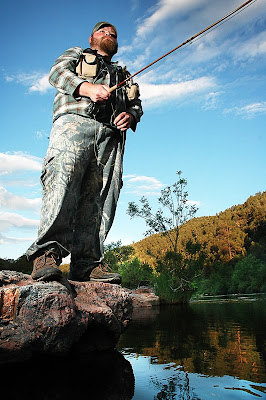As a photographer, I spent a lot of time thinking about the way things are seen. Photography is about the capture of light and the way it plays with the surface of a subject.
Natural light, in my opinion is the best for capturing the soul of just about anything. Food, lit from above and behind by indirect sunlight looks much more appetizing than lit by say, a studio strobe. Take a person and set them beside a shaded window in the warm afternoon glow and you have brilliance ready to shoot.
Flash photography is great due to the ability of the photographer to move the light source and adjust its strength to get the perfect combination of highlights and shadows, and when combined with natural light it can be very powerful.
This cow skull, which Aaron named "Elmer" was sitting in our camp site when we arrived at the river, and I knew sooner or later it would end up in a photo. It was just the when and where I had to figure out.
When I go on fishing trips, there is always a little battle in my head with how much camera to bring. Do I want to leave my "trip Nikon" at home and just throw a point and shoot in my pocket? Or will I be kicking my own ass when some once-in-a-lifetime photo comes along and I don't have my gear to capture it to the best of my ability?
On this trip I brought a Nikon D70, with a SB800 flash and a remote cable. The cable allows me to hold the flash off to a side and get more contrast and shadows which I feel always lends itself to more interesting looking images.
One thing I like to do a lot, is hold the camera down by the ground and shoot up. While it is usually not the most flattering way to photograph people, I find it more interesting to look at than your usual straight-on images. A photograph of something from an angle that people don't see it from in everyday life is a great way to add some snazzieness.
Is it a pain in the ass to cart around a camera like this out in the field? Sure, but sometimes the results are worth it.
Aaron floating a bugger. Lit by the flash while the camera was held just above the water.
Popping the flash with a slow shutter speed at dust gives the water and rocks in the foreground more dimension while still allowing that "flowing" look.
If after all this, you are sitting there thinking, "yea okay, that's neat and all... but how was the fishing?" We caught quite a few little smallmouth on beadhead buggers and reservator leaches. All hanging out where you would expect them, in slow holding water under cover. You have to get a ways up or down the river away from the camping adn people to find the bigguns, and apparently we didn't walk far enough. But overall the trip was a blast.
I plan to do some technique and gear articles about field photography in the future, so if this interested you, stay tuned.
I plan to do some technique and gear articles about field photography in the future, so if this interested you, stay tuned.
-Alex who wants to help you take better photos.











